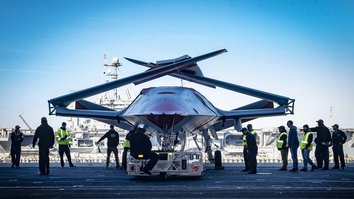The US Navy's first-in-class, nuclear-powered aircraft carrier USS Gerald R. Ford (CVN-78) is slated to embark on its first worldwide deployment later this year.
Built on the legacy of today's Nimitz-class aircraft carriers, the Ford-class carrier will be the most advanced ship on the sea, ensuring the Navy remains ready for crisis response and early striking power in a major combat operation.
While larger than its predecessor, the $13.3 billion Ford carrier will have between 500 and 900 fewer crew members.
"This is a brand new first-in-class unique weapon system," Carrier Strike Group 12 (CSG-12) commander Rear Adm. Gregory Huffman told USNI News in early March.
![Sailors and Boeing employees look for discrepancies in the positioning of the Boeing unmanned MQ-25 aircraft aboard the carrier USS George H.W. Bush (CVN 77) on December 9, 2021. [US Navy]](/cnmi_ca/images/2023/03/31/41450-211209-n-sy758-1005-585_329.jpg)
Sailors and Boeing employees look for discrepancies in the positioning of the Boeing unmanned MQ-25 aircraft aboard the carrier USS George H.W. Bush (CVN 77) on December 9, 2021. [US Navy]
![Hundreds of sailors aboard the USS Gerald R. Ford (CVN 78) stand at attention last November following the ship's inaugural deployment. [US Navy]](/cnmi_ca/images/2023/03/31/41451-7528834-585_329.jpg)
Hundreds of sailors aboard the USS Gerald R. Ford (CVN 78) stand at attention last November following the ship's inaugural deployment. [US Navy]
The carrier is named after the 38th president of the United States, who himself attained the rank of lieutenant commander in the Navy, serving on the light carrier USS Monterey (CVL 26) during World War II.
The USS Gerald R. Ford is powered by two highly enriched uranium nuclear reactors with four shafts, capable of a top speed of around 30 knots (55.5km/hour).
The carrier, combined with the ships in an accompanying carrier strike group, will be capable of conducting a wide range of missions from large-scale combat operations to deterrence and humanitarian assistance, according to the US Navy.
The class, with a planned total of 10 ships, will replace the Navy's current Nimitz-class carriers on a one-for-one basis, starting with the lead ship, Gerald R. Ford (CVN-78), replacing Enterprise (CVN-65).
CVN-78 was commissioned into service in 2017, while the second ship of the class, John F. Kennedy (CVN-79), is expected to go into service in 2024.
New, improved technologies
The new vessels have a hull similar to the Nimitz class but introduce new technologies such as the Electromagnetic Aircraft Launch System (EMALS), which provides for more accurate speed control and smoother acceleration, according to the US Navy's All Hands Magazine.
The Advanced Arresting Gear (AAG) System, meanwhile, allows for the recovery (timely and safe removal) of a broader range of aircraft and reduces the fatigue-impact load on the recovered platforms, thus lengthening the aircraft's life cycle.
Other new technologies include advanced weapons elevators (AWEs) that use electromagnetic motors rather than cables and pulleys.
The advanced technology enables fewer sailors to safely move up to 52,800kg of ordnance at 45.7 metres per minute from weapons magazines to the flight deck with unparalleled speed and agility, according to the Navy.
The biggest visible difference from earlier super carriers is the lesser size and the location farther aft of this ship's island, from which flight operations are conducted.
This design allows for more space for flight deck operations and aircraft maintenance, enabling the ship and air wing to launch more aircraft sorties per day, according to All Hands Magazine.
The carrier will accommodate increased sortie rates at 160 sorties a day (compared with 140 sorties for the Nimitz class), with surges to a maximum of 220 sorties a day in times of crisis and intense air warfare, Naval Technology reported in 2020.
Aircraft and weapons
The Ford-class carrier will be armed with the RIM-162 evolved Sea Sparrow missile (ESSM), a medium-range, surface-to-air interceptor that defends against high-speed, highly manoeuvrable anti-ship missiles.
The ESSM also defends against low-velocity air threats, such as drones and helicopters, according to the Centre for Strategic and International Studies' Missile Defence Project.
The carrier has the ability to carry up to 90 aircraft, 15 more than the Nimitz class.
The aircraft package includes the F/A-18E/F Super Hornet, EA-18G Growler Electronic Attack Aircraft, C-2 Greyhound, E-2D Hawkeye, F-35C Lightning II, SH-60 Seahawk helicopters, and unmanned combat aerial vehicles.
Other airframes may eventually include the MQ-25 Stingray, the world's first operational, carrier-based unmanned aircraft.
The Stingray provides aerial refuelling as well as intelligence, surveillance and reconnaissance capabilities for the Carrier Strike Group.
The carrier has also installed refuelling hoses on the deck and established a fueling area allowing it to launch and recover while simultaneously refuelling aircraft.
Given the extra forward deck space, some aircraft such as the E-2D Hawkeye will be able to land, refuel and take off with the crew never leaving the aircraft.

![Aircraft attached to Carrier Air Wing (CVW) 8 sit on USS Gerald R. Ford's (CVN 78) flight deck as the ship steams through the Atlantic Ocean last April 13. [US Navy]](/cnmi_ca/images/2023/03/31/41449-uss-ford-585_329.jpg)







It's like the Admiral Kuznetsov but with no smoke )))
Reply1 Comment(s)